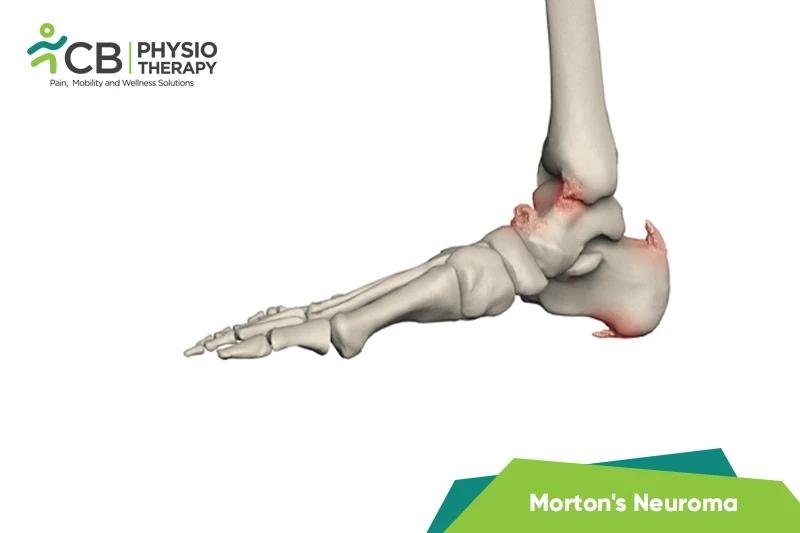
An ankle bone spur or osteophyte is a hard and smooth bump of extra bone that usually develops near joints. It is a bony growth formed on normal bone, as the body tries to repair itself by building extra bone. It is generally formed in response to constant pressure or stress over a long time.
A bony spur is an extra bone that can occur at places such as the spine, shoulders, hands, hips, knees, and feet. It can occur due to:
Most bone spurs are without symptoms. But if the bone spur presses on other tissues or bones or causes a muscle or tendon to rub, then it can break that tissue down over time, causing:
Pathology:
A bone spur is a tiny pointed outgrowth of bone, caused by local inflammation, such as osteoarthritis or tendonitis. Bone spurs develop in areas of injury or inflammation of the nearby cartilage or tendons.
Physical Examination:
The examiner requires the medical history of the patient and conducts certain physical examinations to determine the cause of the pain.
CT scan:
CT scan is one of the most advantageous procedures and is ideal for detecting the bone spur and also reflects how the adjacent soft tissues are affected by the bone outgrowths.
Magnetic resonance imaging (MRI):
Magnetic resonance imaging is a sensitive diagnostic technique. It helps in assessing and identifying the changes that occur in the tissues and bones. It can be also utilized for revealing bone spurs.
Ultrasound imaging:
Ultrasound imaging is helpful in identifying bone spurs and evaluating the muscles and ligaments around the joints. In case of bone spurs, the ligaments can be stretched or even torn.
X-ray:
X-rays help to indicate bone spur formation and highlight the degeneration of the spinal cords. The X-ray also indicates the distance between bones.
Medication: Nonsteroidal anti-inflammatory drugs, Corticosteroid injection, Naproxen Sodium, Acetaminophen, Ibuprofen, etc.
Note: Medication should not be taken without the doctor's prescription.
Surgery:
Bone spurs do not require treatment unless they cause pain or damage to other tissues. In case of excess pain, conservative treatment is recommended. However, in some severe cases, surgery is recommended, when the pain becomes unbearable, and starts affecting the movement of body parts. Overall, the surgical operation involves minimally invasive techniques.
Cryotherapy or ice therapy are both effective for treating chronic heel spurs. It may be used to relieve inflammation and reduce pain.
Thermotherapy helps to loosen tense muscles and promote oxygen and blood flow to the affected area. Heat therapy might also be effective for reducing pain during exercises.
Low laser therapy:
Low-level laser therapy (LLLT) is found to be an effective method for treating heel spurs.
Deep tissue massage may be helpful for heel spurs, by increasing blood circulation and removing toxins.
Therapeutic ultrasound is proved to be effective in relieving pain and swelling.
Extracorporeal Shock Wave Therapy (ESWT):
ESWT is an advanced technology modality used by physiotherapists to ease pain and decrease swelling.
Night Splints:
Night splint keeps the ankle in 5-degree of dorsiflexion for a few weeks Patients feel relief from heel pain in the short term when the use of a night splint is incorporated into a conservative treatment procedure.
Heel Inserts:
Heel inserts relieve heel spur pressure and inflammation by distributing the pressure evenly throughout the heel reducing stress.
Orthotics:
Customized orthotics are useful in distributing pressure uniformly over the rearfoot region.
Footwear Modification
Proper footwear provides relief from heel pain and heel spurs as it aims to correct over-pronation, fallen arches, and flat feet.
Passive and active stretching:
Strengthening and stretching of the muscles is done to eliminate inflammation surrounding the spur. The treatment program may take 6 to 12 months for relieving symptoms.
The patient is advised to keep the bones and joints healthy. These include maintaining a healthy weight, wearing footwear with proper support, and doing regular workouts.
Select your City to find & connect with our experts regarding Physiotherapy for Ankle Bone Spur